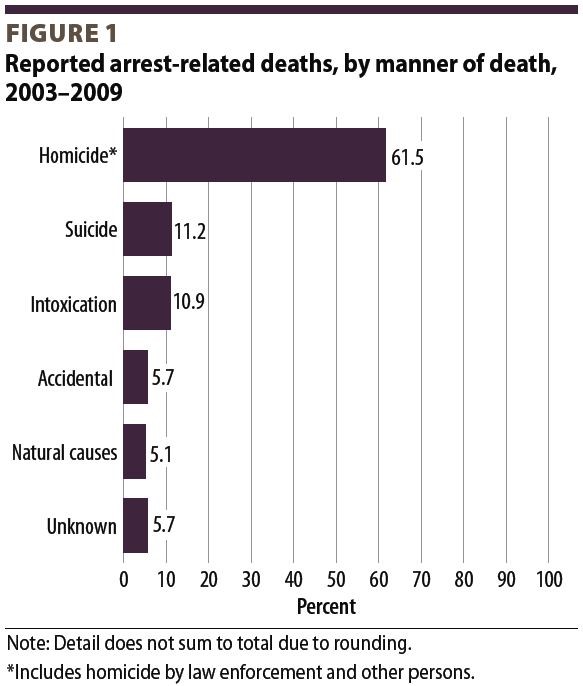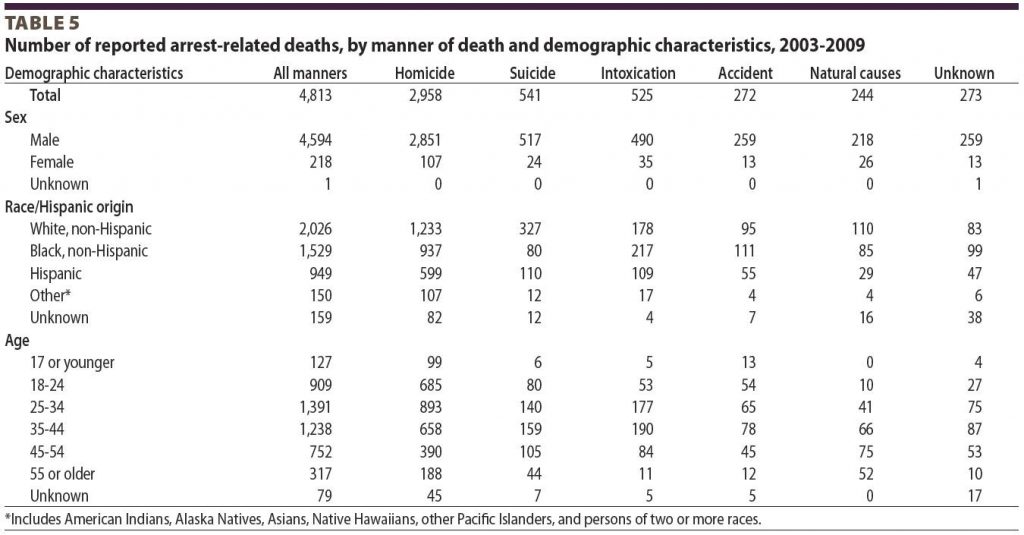By: Victor E. Kappeler, Ph.D.
The evidence continues to mount for what every critical criminologist or police scholar already knows; that even in so-called “post-racial” America, police brutality is still disproportionately directed at people of color—often with fatal consequences. A recently released study by the Bureau of Justice Statistics (2011) entitled “Arrest-Related Deaths, 2003-2009-Statistical Tables” is no exception to this observation. Yet, as is often the case with government-generated research, especially with BJS research on policing, data are presented in ways that mask critical evaluation of the material. Likewise, the information presented by BJS is often cluttered with secondary data that tends to minimize critical interpretation.1 That having been said, there are some interesting, if not disturbing, observations that can be made from the limited data presented in their report on arrest related deaths (ARD).2

According to the report, between 2003 and 2009 at least 4,813 people died in the process of being arrested by local police. Because of a lack of reporting by local police agencies and even entire states as well as the exclusion of deaths during arrests made by Federal law enforcement officers, this total certainly underreports the number of people who died while being arrested by law enforcement officials.3 For example, the New York Times reports that between 1993 and 2011 the FBI fatally shot about 70 people (Savage and Schmidt, 2013) and these fatalities would not be included in the BJS report. The same limitations would apply to the hundreds of federal agencies with arrest powers.

The report classifies ARD into one of six categories and the percentages are reported in Figure 1. Limiting the total number of cases to those that reporting the race of the decedent results in a total of 4,654 ARD during this time period. Of this total where race was known 2,628 or 56.5 percent of deaths were people of color. People of color were over-represented in every manner of death category the BJS used with the exception of suicide. When one looks solely at the category of deaths classified as law enforcement “homicides,” 2,876 deaths occurred of which 1,643 or 57.1 percent of the people who died were people of color. Given the fact that according to US Census data for 2010, 72.4 percent of the American population classified themselves as white, people of color are dying during the arrest process at more than twice their representation in the American population. Curiously, people of color who die during the arrest process are also disproportionately likely to have their deaths classified as the result of accident, natural causes, or intoxication. Table 5 above shows the number of deaths by category and the manner of death for the seven year time period.
What is clear from a critical analysis of the data presented in the BJS report as well as what is left unsaid in the government’s reporting is the simple fact that even in a so called “post-racial America,” being arrested by the police can have fatal consequences especially if you are a person of color.
Victor E. Kappeler, Ph.D.
Associate Dean and Foundation Professor
School of Justice Studies
Eastern Kentucky University
Notes
1 For example, in this BJS report the agency implies comparison of the total deaths they report with the total number of arrests reported by other agencies during the time period covered, but the BJS report does not control for the lack of agencies and states responding. Thus creating the impression deaths during arrest are a lower percentage. Also notice how in Figure 1 the BJS does not report frequencies and in Table 5 they do not report percentages. Failure to report percentages in Table 5 and failure to discuss them in the narrative create the need for this essay.
2 “For this data collection, BJS defines “in the process of arrest” to include all circumstances in which a person is in the custody or under the restraint of law enforcement officers. This definition includes situations in which a formal arrest process was neither initiated nor intended. It includes instances in which law enforcement personnel actively pursue or attempts to apprehend a criminal suspect, regardless of whether physical custody was established. In addition, it includes deaths that involved law enforcement assistance in restraining and transporting individuals in need of medical or mental health care” (BJS, 2011: p. 14).
3 “BJS did not attempt to estimate for partial or non-responding jurisdictions. Data are more representative of the nature of arrest-related deaths than the volume at which they occur” (BJS, 2011: p. 1).
References
BJS (2011). Arrest-Related Deaths, 2003-2009 – Statistical Tables. Washington, DC: U.S. Department of Justice, Office of Justice Programs. http://www.bjs.gov/index.cfm?ty=pbdetail&iid=2228
Savage, C., and Schmidt, M. S. (2013). “The F.B.I. Deemed Agents Faultless in 150 Shootings.” New York Times, June 18, 2013. http://www.nytimes.com/2013/06/19/us/in-150-shootings-the-fbi-deemed-agents-faultless.html?_r=0
